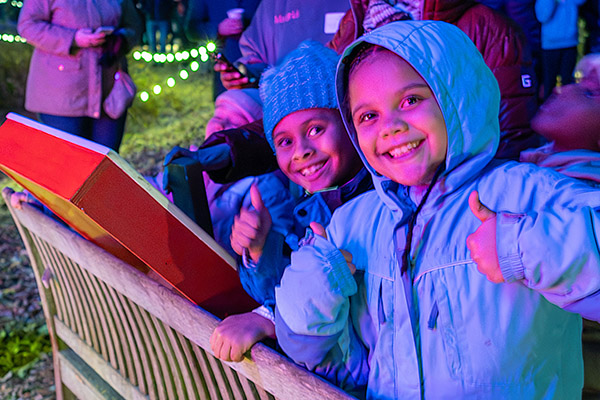It’s the holidays! The season for garland, wreaths, and other holiday decoration is here. Have you given thought to how you can incorporate more natural décor into your usual setup? Maybe a more sustainable option for your holiday tree or outdoor decorations?
The Garden works to include a number of environmentally-friendly aspects into WPS Garden of Lights, both indoor and outdoor options, each year.

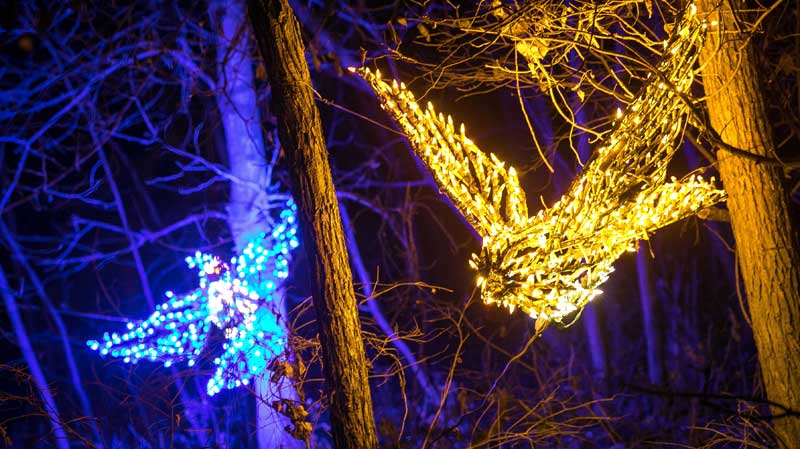
Here are few tips we’ve put together you can try at home!
Natural or Plastic Holiday Trees
There are pros and cons to choosing natural trees or plastic trees for the holiday season, but it all depends on your desires for décor.
If you opt for a natural pine or evergreen tree, we recommend trying to get one from a local organization that grows them on a farm or sources from one. These tree farms leave forests untouched and will typically plant a new tree for every one harvested. The farms can also act as a habitat for local birds, insects, and wildlife in their area.

Once the holiday season is over, make sure you dispose of it properly, whether that’s looking for a responsible pickup program in your neighborhood, composting it yourself, or even replanting it on your property if you have enough space.
Fake holiday trees are usually made from an unrecyclable plastic material. At the surface, choosing a plastic tree to celebrate the holiday season may not be a good option, but they are reusable. To be eco-friendly, try to reuse your tree for at least 10 years. Sometimes they can last 20-30!
For those who may not have the space for a full tree, the same principles work. You can either find more natural, smaller options like potted trees or plants like poinsettias or reuse small, fake trees from year to year.

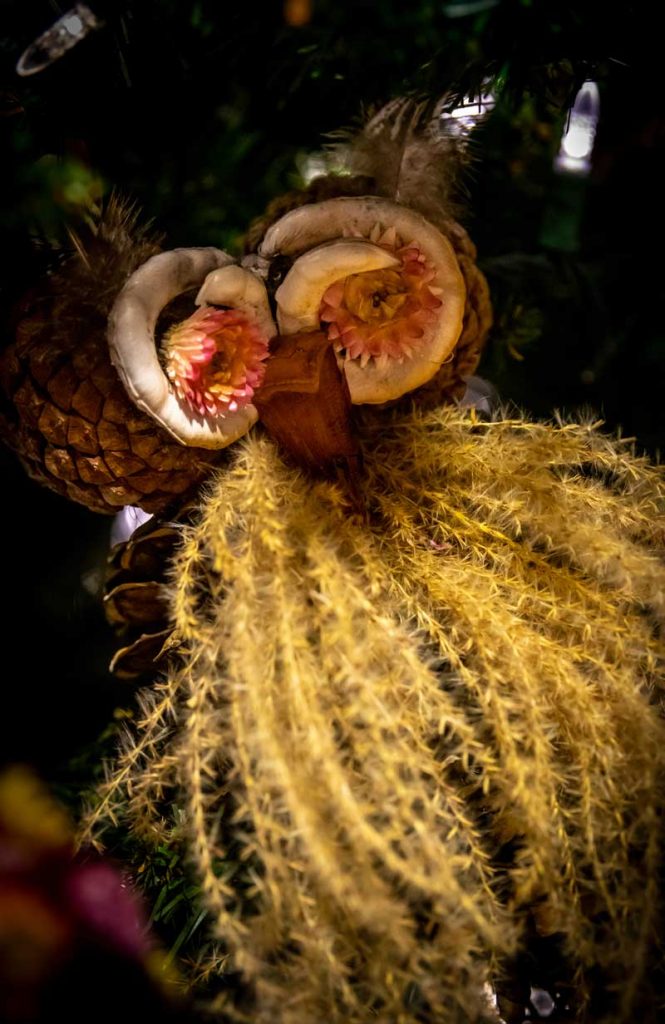
Natural Ornaments & Other Items
Another reliable sustainable option are natural ornaments and other decorations, things like popcorn garlands, salt-dough decorations, and dried natural items found in nature including pinecones, fruit slices, and twigs. You can also use items from around the house to make ornaments like old board game pieces, mason jar lids, buttons, and more. All of this stuff can be hung on a tree or strung up with a string!
The Garden also dabbles in natural decorations for our indoor holiday trees in both the Fischer Visitor and Schneider Education Centers. You may have seen them in years past during WPS Garden of Lights!

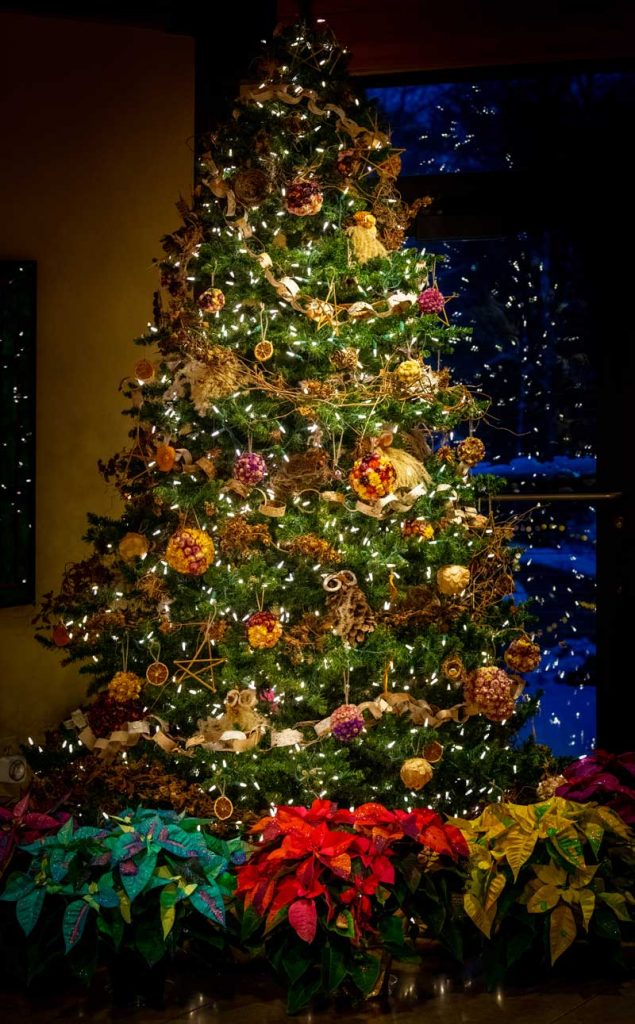
Our Horticulture Team and volunteers collect, dry, and assemble a variety of organic items found in the Garden, including dried strawflowers, globe amaranth, and acorn caps. Natural garlands are made with marigolds, pinecones, and even ornamental peppers. We collect new material every year since colors fade, and dried material can become very brittle.
Scroll down to the end of this blog for a step-by-step guide of our process!
Wreaths & Outdoor Decor
When it comes to wreaths and other outdoor décor, it’s important to try and use organic options or plastic options that have little to no adornments and accessories. Since these items are outdoors, it can impact wildlife positively (wreaths can double as homes for small, local birds that overwinter) or negatively (animals can accidentally eat plastic beads or glitter pieces that fall off).

Indoor & Outdoor Lights
Bright lights and the holidays go hand in hand.
Choosing LED lights whenever possible is always a good choice as they use 90% less energy than traditional lights. We use between 325,000-340,000 LED lights and less than 1,000 incandescent lights during WPS Garden of Lights.
Solar-powered lights are another sustainable outdoor option. They charge during the day and don’t use any energy from the grid, but they aren’t usually as bright as LEDs.
We also recommend having your outdoor lights on a timer to make sure you aren’t using more energy than you need and that you don’t have lights on the entire night, which could be disorienting and negatively impact local wildlife.
One last note… recycle old strings of lights if you can, otherwise they’ll definitely end up in your local landfill.

PC: John Oates Photography
Reuse as Much as You Can
Overall, one of the best ways you can be sustainable when decorating for the holidays is to reuse as much as you can from previous years. We recommend taking advantage of any items passed down from older family members or friends. You can also ask close family and friends if they have any extra decorations they don’t plan on using and would be sharing with you. Then, there’s always the option to explore local thrifting stores and other second-hand locations.
These are just a few tips for natural and sustainable holiday decorations. Trying out just one tip can put you on the path to being more environmentally friendly this time of year!
For more natural décor inspiration, make sure you check out our Natural Holiday Trees during WPS Garden of Lights or whenever the Garden is open this season.

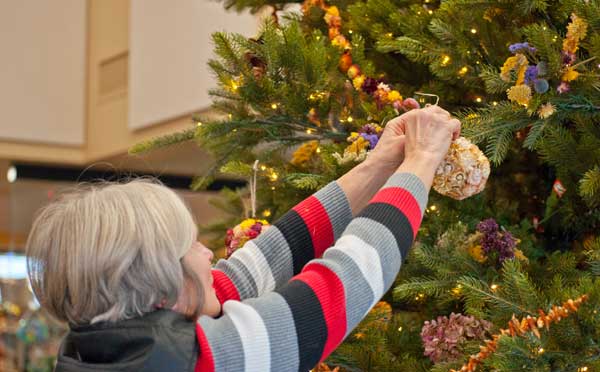
PC: C Gleason
Our Natural Décor Drying Process
- In winter, we plan which annual flowers will be grown in the cutting garden for their ability to retain their color and shape once dried for the tree.
- We begin to collect and dry the flowers as soon as they come into bloom in the summer. How much do we collect? We simply collect until we think we have enough.
- The drying process begins immediately after the flowers are collected. Air-dried flowers are tied into bundles and hung in a dry, dark place. These include: statice, lavender, yarrow, strawflower, allium, globe amaranth, and hydrangea.
Flowers best dehydrated with a special drying agent (such as silica sand) are dried for a week or so in the sand and then are removed and stored. These include: hydrangea, rose, black-eyed susan, dahlia, Queen Anne’s lace, and zinnia. - Seed heads of plants can also be used. These include: poppies, globe thistle, and silver dollar plant.
- In early fall, we gather our volunteers and make small ‘bouquets’ with all the dried plant material. Like snowflakes, each bouquet is unique.
- A few weeks after assembling the bouquets, it’s time to decorate the tree!
- After WPS Garden of Lights is over, we deconstruct the tree, save the best and brightest bouquets, and store them in plastic totes in our dark, dry storage room.
Sources






